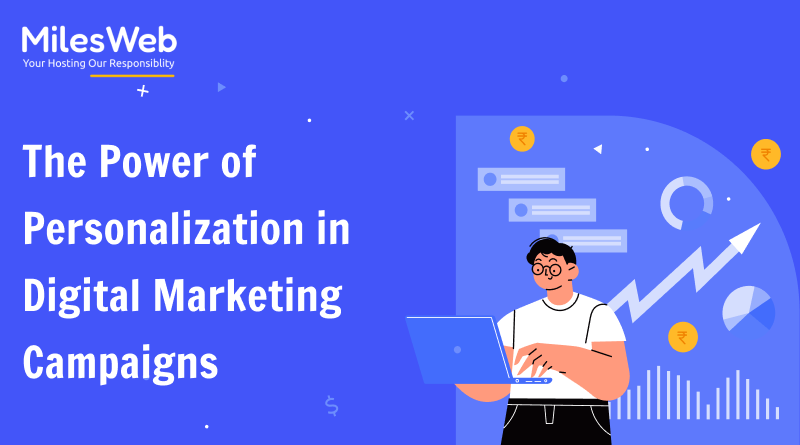In this ad-saturated world, consumers are overwhelmed by advertisements at every turn. From banner ads on websites to targeted Facebook and Instagram updates, the digital world is filled with content. Amid this chaos, the question for marketers is: what sets you apart? The answer lies in personalization. It’s not just a technique—it’s the secret recipe that transforms customer interactions into meaningful connections.
Personalised digital marketing has become one of the most influential techniques for brands to connect with customers. By customising messages, promotions, and experiences to individual choices, promoters can build more relevant interactions with their potential customers. Whether you’re promoting PHP web hosting solutions, personalisation is no longer a buzzword—it’s a requirement for any brand that wants to stay competitive in today’s saturated marketplace.
Additionally, if you are using the cheapest Laravel hosting services or other solutions, personalisation can ensure that your message blends perfectly with clients’ needs. In this blog, we will discuss the potential of personalisation in online marketing, why it is effective, and how brands can leverage this strategy to achieve greater customer engagement and ultimately drive higher sales.
What is Marketing Personalisation?
Personalisation means featuring personalised content, suggestions, to users depending on their behaviour, activities, and preferences. As data spread and advanced analytics software became widespread, companies are now capable of getting insights into customers’ behaviour and thus segmenting audiences and writing messages targeted for specific audiences.
But how does personalisation succeed so effectively? The answer is rooted in customer psychology. In a world where we’re bombarded daily with ads, consumers are increasingly wary of common, conventional messages. Personalised marketing addresses a consumer’s personal needs and desires straightaway. It shows that a brand is aware of the consumer’s choices, hence creating trust and an even stronger relationship.
Personalisation also directly influences shopping conversions. According to a study by Segment, around 50% of customers have bought something they didn’t originally intend to when offered product recommendations. Whether for personalised product recommendations, targeted email campaigns, or customised ads, this tactic promotes impulse purchases, boosts conversion chances, and can even lead to increased average order values.
The Role of Data in Personalisation
Data is one of the most significant pillars of effective personalisation marketing. Marketers can collect valuable data over a number of different channels, such as visits to websites, social media engagement, purchase records, and even geolocation. With all this data in hand, brands can create rich profiles of their customers that allow them to forecast how they will behave and serve extremely personalised content.
For instance, online brands such as Flipkart are experts in personalisation marketing. By monitoring the web history and past purchases of a customer, Flipkart makes suggestions to the specific client, paving the way for conversion. Similarly, Netflix applies data to provide movie and television show suggestions based on watching behaviour, engaging the user with the website.
Nonetheless, with data increasingly playing a key role in digital marketing, there have been increased concerns around privacy. Consumers are getting more conscious about the collection and use of their data, and increasingly, they are worrying about their privacy. Brands thus need to make sure they are open with data collection processes and provide consumers with ownership over their data. The introduction of laws like GDPR in the European Union and CCPA in California has increased the importance for brands to treat customer data sensitively.
Personalization on Multiple Digital Channels
Personalization is not restricted to a single channel. Actually, to have an experience that is seamless and effective, brands need to layer personalization on multiple digital touchpoints. This may involve websites, social media, email marketing, search ads, and much more.
Website Personalization
When a user comes to a website, they should get the impression that the brand comprehends him or her. This can be as easy as displaying a greeting with the user’s name or location, or as sophisticated as suggesting products based on his or her browsing history. Samsung and Apple are great at this, with product suggestions and content tailored to a user’s past behaviour on their website.
Email Marketing
Email is still one of the most powerful channels for one-to-one marketing. By segmenting email lists by customer interests or behaviours, marketers can send highly targeted messages to each customer. For instance, an e-commerce company may send a special offer to a customer who has left their shopping cart, encouraging them to purchase.
Social Media
Social media websites such as Facebook, Instagram, and Twitter provide companies with an abundance of tools for personalized marketing. Brands can build customized audiences based on demographic data, interests, and behaviours, which enables them to deliver highly targeted advertisements. Furthermore, tools such as Facebook Dynamic Ads enable companies to automatically present users with products that are most relevant to them based on browsing history.
Search Marketing
Google and other search engines also performs a crucial role in personalised marketing. With retargeting advertisements and customised search results, brands are able to target users at the very moment they are looking for products or services that suit their requirements.
Challenges and Best Practices for Personalisation
As personalisation offers remarkable benefits, it comes with its intricate challenges. Brands need to make sure not to overstep their bounds or get too cosy, so to speak. There is a very minute difference between remarketing and annoying marketing. For instance, sending promotional emails for products that one just bought or follow-up advertising too soon after a customer has already purchased something to give them an adverse experience.
To steer clear of these traps, brands must adhere to these best practices:
- Use Data Wisely
Brands must gather and analyse customer data responsibly. They must use data to enhance the customer experience and provide value, not just to push sales.
- Ensure Transparency
Inform consumers clearly about how their information will be utilised. Use clear, understandable privacy policies and allow consumers to control their information.
- Don’t irritate the Customer
Personalised marketing can be impactful, but bombarding consumers with too many targeted messages can annoy them and result in ad fatigue. Strive to balance relevance and repetition.
- Test and Optimise
Personalisation is a continuous process. Brands need to keep testing various strategies and optimizing their campaigns on the basis of customer feedback and engagement metrics.
Conclusion
Personalisation has transformed the online marketing industry by allowing businesses to have healthy relationships with their customers. By using data to provide personalised content, products, and experiences, businesses can boost customer engagement, develop brand loyalty, and generate increased sales.
Personalisation comes with the responsibility of managing consumer information decently. For businesses looking to support their personalised marketing efforts, MilesWeb provides robust and secure hosting solutions that ensure your personalised content is delivered effortlessly to your audience, enhancing user experience and driving engagement.




